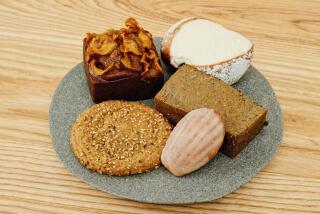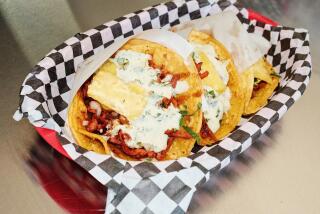The king of dumplings reigns here
- Share via
As we tackled a plate of calzone-size pastas stuffed with beef and kimchi, my Korean friend gave me some background. “Wang mandu translates as king dumplings,” she said.
These gigantic dumplings are the hallmark of the North Korean province Hwanghae. The best of them -- like the ones served at Hwang Hae Do restaurant in Artesia -- enclose a filling of vegetables and braised beef in taut, translucent skins.
Like pirogi, kreplach and ravioli, wang mandu are associated with family gatherings and festive events. They’re rarely seen in restaurants.
I stumbled onto Hwang Hae Do while checking out the curry depots of Artesia’s Little India. Among the usual Korean dishes, its menu lists steamed wang mandu, fried wang mandu and wang mandu soups and casseroles.
“What’s the flavoring in these?” I asked owner Scott Kim, when he stopped by our table.
“The recipe’s my mother-in-law’s secret,” he replied with a cagey grin. “She makes all our mandu.”
His mother-in-law, Un Kim, has been making the dumplings professionally for the better part of her 74 years. Kim says her family popularized them in South Korea -- or at least in the city of Cho Chun, where they opened a restaurant after leaving the war-torn north.
After the Kims moved to Southern California in the late ‘80s, they opened a chain of Hwang Hae Do restaurants, and although they have since sold all but the Artesia branch, the other restaurants still serve Mrs. Kim’s dumplings.
The dumplings come in two varieties, big ones with a mild beef and zucchini filling and even bigger ones filled with kimchi, beef and crumbled tofu. You can ask for either kind in any of the restaurant’s dumpling dishes, which include steamed, cooked pot-sticker style, in a casserole and in broth.
Purist that I am, I ordered the plain steamed beef and zucchini wang mandu on my first visit. My dumplings -- five of them, more than I thought I could possibly eat -- came with a powerful chile-soy dipping sauce shot through with sesame seeds. The handmade wrappers were thin, springy and ever so slightly uneven; the carefully chopped meat was unlike the pasty filling of the frozen dumplings sold in Korean supermarkets.
Accented with just a slight sparkle of chile heat, every dumpling managed to disappear as I made a mental list of dumpling lovers who would be forever indebted to me for turning them on to this find.
One Sunday, I organized a feast in which every course would be dumplings. As an appetizer we tried zucchini wang mandu cooked pot-sticker style, which the menu erroneously describes as deep-fried. Maybe they weren’t deep-fried, but they were miracles of crispness; their fragile exteriors, as brittle as filo, melted into the deeply flavored meat. Next came kimchi wang mandu in a light beef broth.
The main course, the house specialty dumpling casserole in a heavy cast-iron pot, was a cook-at-the-table extravaganza. We armed ourselves with the traditional long-handled steel spoons and poked into the garlic-scented, fire-engine-red broth, where thick noodles, vegetables and a thatch of pungent amaranth greens, wilted into the liquid, all floated together. Underneath, like hidden treasure, lay both kinds of mandu.
“The large ones are winter mandu,” my friend volunteered, as we lifted the chubby packets into our own bowls. Their taste transported her back to the days when the women of her family gathered in the kitchen to gossip and make wang mandu by the hundreds. Kimchi, she explained, was often the only vegetable available during North Korea’s bitterly cold winters. The finished dumplings were put on trays and stored outside in the frigid air, ready to be offered to guests on New Year’s Day for good luck.
In addition to these substantial dishes at Hwan Hae Do, you can get smaller servings of the dumplings at lunch, either plainly boiled or in spicy broth with chewy rice cakes. If you don’t want to limit your meal to mandu, this pleasant family-style restaurant has plenty of other Korean dishes to choose from.
And I noticed customers leaving with bags and even coolers loaded with frozen mandu, which are sold from an old-fashioned freezer near the door.
*
Hwang Hae Do
Location: 11748 E. Artesia Blvd., Artesia, (562) 402-6509. Also: 429 N. Western Ave., Los Angeles, (323) 468-3839; 1100 San Pedro St., Los Angeles (open 8 a.m. to
5 p.m.), (213) 749-1100; 9448 Garden Grove Blvd., Garden Grove, (714) 590-1588.
Price: Dumpling dishes, $7.99 to $12.99; plain dumplings (lunch only), $5.99.
Best dishes: Dumpling casserole, special giant dumpling soup, “deep fried” dumpling (cooked pot-sticker style), steamed dumpling.
Details: The Artesia restaurant is open 10 a.m. to 10 p.m. daily. Beer and soju liquor. Parking lot. MasterCard and Visa.
More to Read
Eat your way across L.A.
Get our weekly Tasting Notes newsletter for reviews, news and more.
You may occasionally receive promotional content from the Los Angeles Times.










